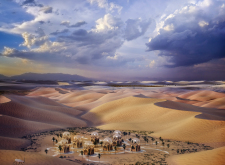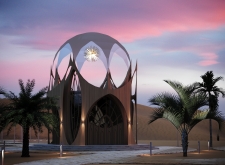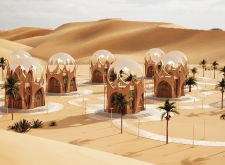5 key facts about this project
The architectural design project, situated in a desert environment, embodies a modern response to the challenges of sustainable living within an arid landscape. The primary objective is to create a functional habitat that aligns with the ecological characteristics of the site while promoting communal interaction. The design incorporates organic forms that mimic the surrounding natural landscape, enhancing the overall aesthetic and spatial experience.
The project serves various functions, including residential, recreational, and communal spaces, arranged in a semi-circular layout that fosters social connectivity among inhabitants. Central gathering areas provide opportunities for community engagement, while private spaces maintain a sense of individuality and comfort.
One of the notable aspects of this architectural design is its emphasis on sustainability. The selection of materials respects local resources and minimizes environmental impact. Wood is utilized for structural frames, providing warmth and sustainability. Glass elements maximize natural light, promoting energy efficiency while delivering panoramic views of the desert. Local stone is employed for pathways, ensuring durability and harmony with the surroundings. Concrete serves as a robust material capable of managing the region's temperature extremes, while also offering flexibility in design.
The distinctive organic forms of the structures set this project apart from typical desert architecture. Curvilinear shapes not only reflect the natural contours of the sand dunes but also contribute to effective wind flow and temperature regulation within each space. Strategic design elements, such as shaded areas and cross-ventilation, enhance occupant comfort in a challenging climate.
In examining the intricacies of the design, it becomes apparent that the project prioritizes the integration of indoor and outdoor experiences. The carefully planned landscaping includes local flora, complementing the architectural forms and creating an inviting atmosphere. The tangible connection between the built environment and its natural context underscores the project’s commitment to sustainability and ecological respect.
For those interested in a deeper analysis of this architectural endeavor, further exploration of the architectural plans, architectural sections, and architectural designs will provide valuable insights into the innovative ideas employed in this project. Engage with the full presentation of the project to appreciate the comprehensive approach taken in addressing both aesthetic and functional design challenges.





















































